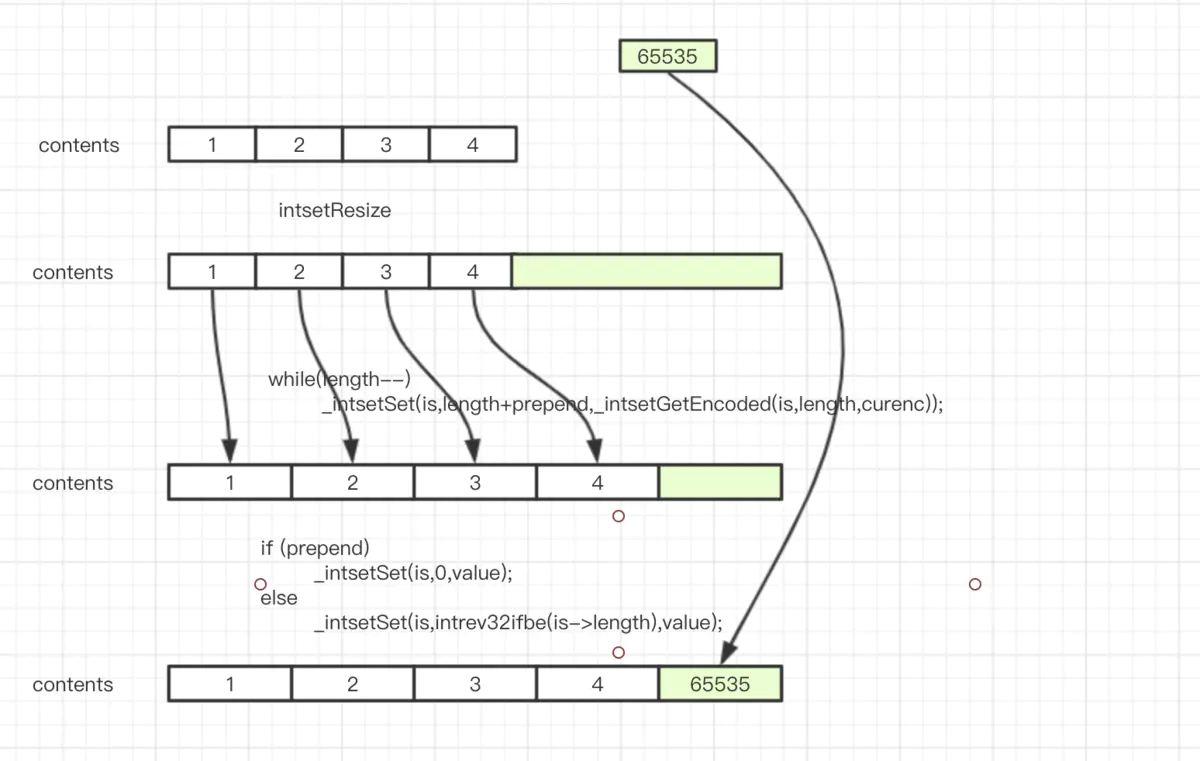整数集合,是一个有序的数值数组对象,存储的数值不允许重复。源码在 intset.c
1. 数据结构
1
2
3
4
5
6
7
8
9
10
11
/* Note that these encodings are ordered, so:
* INTSET_ENC_INT16 < INTSET_ENC_INT32 < INTSET_ENC_INT64. */
#define INTSET_ENC_INT16 (sizeof(int16_t))
#define INTSET_ENC_INT32 (sizeof(int32_t))
#define INTSET_ENC_INT64 (sizeof(int64_t))
typedef struct intset {
uint32_t encoding; // 编码。
uint32_t length; // 数组长度。
int8_t contents[]; // 整数值数值。
} intset;
根据插入数值大小,决定 contents 数组的 encoding 格式。编码格式分别有 int16_t,int32_t,int64_t。以最大的数值为准,如果最大的数值是 int64_t 那么数组的每个 item 都是 int64_t,优点是统一简单,提高数组查找效率——源码实现是通过二分法查找。如果数组不同数值用不同的编码存储,就很难用二分法查找了。
但是这样做一方面提高了查找效率,另一方面也会导致内存浪费,如果所有数据中,只有一个数据是 int64_t,其它数据都是 int16_t,整个数组 item 都以 int64_t 存储,显然会造成内存浪费。
当然 redis 的数据结构是丰富的,连续内存上的数据管理有:字符串对象(sds),压缩列表(ziplist),这里有整数集合(intset),都分别针对不同的应用场景进行应用。
2. 接口
2.1. 数值编码
1
2
3
4
5
6
7
8
9
10
11
12
13
14
15
16
17
18
#define INT8_MAX 127
#define INT16_MAX 32767
#define INT32_MAX 2147483647
#define INT64_MAX 9223372036854775807LL
#define INT8_MIN -128
#define INT16_MIN -32768
/* Return the required encoding for the provided value. */
static uint8_t _intsetValueEncoding(int64_t v) {
if (v < INT32_MIN || v > INT32_MAX)
return INTSET_ENC_INT64;
else if (v < INT16_MIN || v > INT16_MAX)
return INTSET_ENC_INT32;
else
return INTSET_ENC_INT16;
}
2.2. 插入数据
检查插入数据是否大于当前编码格式,决定是否需要升级
1
2
3
4
5
6
7
8
9
10
11
12
13
14
15
16
17
18
19
20
21
22
23
24
25
26
27
28
29
30
31
32
/* Insert an integer in the intset */
intset *intsetAdd(intset *is, int64_t value, uint8_t *success) {
uint8_t valenc = _intsetValueEncoding(value);
uint32_t pos;
if (success) *success = 1;
/* Upgrade encoding if necessary. If we need to upgrade, we know that
* this value should be either appended (if > 0) or prepended (if < 0),
* because it lies outside the range of existing values. */
// 如果插入数值大于当前编码,那么需要升级数组
if (valenc > intrev32ifbe(is->encoding)) {
/* This always succeeds, so we don't need to curry *success. */
return intsetUpgradeAndAdd(is,value);
} else {
/* Abort if the value is already present in the set.
* This call will populate "pos" with the right position to insert
* the value when it cannot be found. */
// 如果数值已经存在,就不需要插入数据了。*success = 0;
if (intsetSearch(is,value,&pos)) {
if (success) *success = 0;
return is;
}
// 数据增长,重新申请内存。
is = intsetResize(is,intrev32ifbe(is->length)+1);
if (pos < intrev32ifbe(is->length)) intsetMoveTail(is,pos,pos+1);
}
_intsetSet(is,pos,value);
is->length = intrev32ifbe(intrev32ifbe(is->length)+1);
return is;
}
2.3. 升级
1
2
3
4
5
6
7
8
9
10
11
12
13
14
15
16
17
18
19
20
21
22
23
24
25
26
27
28
29
/* Upgrades the intset to a larger encoding and inserts the given integer. */
static intset *intsetUpgradeAndAdd(intset *is, int64_t value) {
uint8_t curenc = intrev32ifbe(is->encoding);
uint8_t newenc = _intsetValueEncoding(value);
int length = intrev32ifbe(is->length);
// 因为插入新的数据,而且数据超出了当前数组所有数值的范围才会升级。
// 超出了负数,或者超出了正数。正数在数组末添加,负数在数组前面添加。
int prepend = value < 0 ? 1 : 0;
/* First set new encoding and resize */
is->encoding = intrev32ifbe(newenc);
is = intsetResize(is,intrev32ifbe(is->length)+1);
/* Upgrade back-to-front so we don't overwrite values.
* Note that the "prepend" variable is used to make sure we have an empty
* space at either the beginning or the end of the intset. */
// 扩充内存后,迁移数据。
while(length--)
_intsetSet(is,length+prepend,_intsetGetEncoded(is,length,curenc));
/* Set the value at the beginning or the end. */
if (prepend)
_intsetSet(is,0,value);
else
_intsetSet(is,intrev32ifbe(is->length),value);
is->length = intrev32ifbe(intrev32ifbe(is->length)+1);
return is;
}

2.4. 搜索
二分法搜索数组数据。
1
2
3
4
5
6
7
8
9
10
11
12
13
14
15
16
17
18
19
20
21
22
23
24
25
26
27
28
29
30
31
32
33
34
35
36
37
38
39
40
41
42
43
44
45
46
/* Search for the position of "value". Return 1 when the value was found and
* sets "pos" to the position of the value within the intset. Return 0 when
* the value is not present in the intset and sets "pos" to the position
* where "value" can be inserted. */
static uint8_t intsetSearch(intset *is, int64_t value, uint32_t *pos) {
int min = 0, max = intrev32ifbe(is->length)-1, mid = -1;
int64_t cur = -1;
/* The value can never be found when the set is empty */
if (intrev32ifbe(is->length) == 0) {
if (pos) *pos = 0;
return 0;
} else {
// 检查数值是否大于或小于数组里的所有数值。
/* Check for the case where we know we cannot find the value,
* but do know the insert position. */
if (value > _intsetGet(is,max)) {
if (pos) *pos = intrev32ifbe(is->length);
return 0;
} else if (value < _intsetGet(is,0)) {
if (pos) *pos = 0;
return 0;
}
}
// 数值如果在存储的数据中间,用二分法查找。
while(max >= min) {
mid = ((unsigned int)min + (unsigned int)max) >> 1;
cur = _intsetGet(is,mid);
if (value > cur) {
min = mid+1;
} else if (value < cur) {
max = mid-1;
} else {
break;
}
}
if (value == cur) {
if (pos) *pos = mid;
return 1;
} else {
if (pos) *pos = min;
return 0;
}
}

